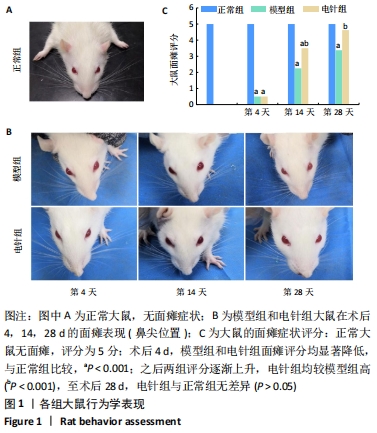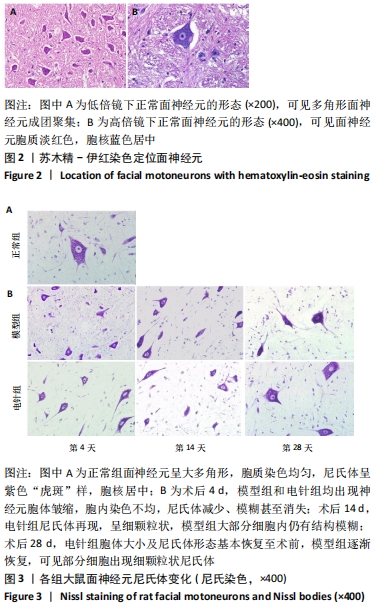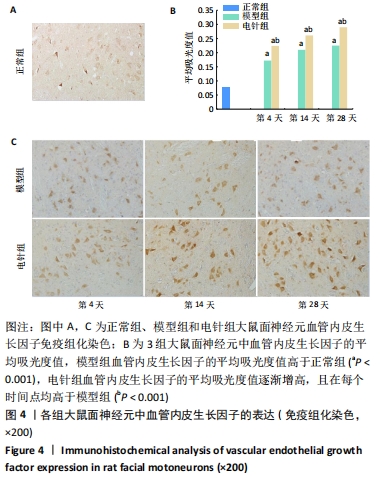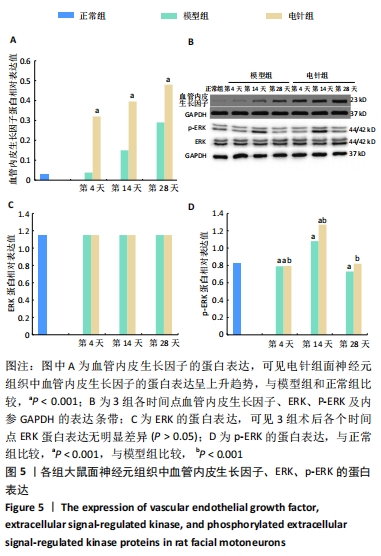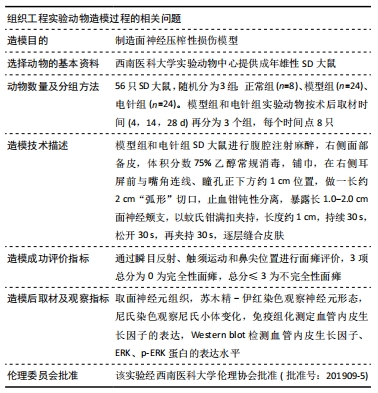中国组织工程研究 ›› 2022, Vol. 26 ›› Issue (11): 1728-1733.doi: 10.12307/2022.358
• 组织构建实验造模 experimental modeling in tissue construction • 上一篇 下一篇
电针干预面神经压榨模型大鼠促进面神经的再生
费 静1,陶美惠2,李雷激1
- 1西南医科大学附属医院耳鼻咽喉头颈外科,四川省泸州市 646000;2成都市双流区第一人民医院耳鼻咽喉科,四川省成都市 610200
Electroacupuncture promotes facial nerve regeneration in a rat model of facial nerve crush
Fei Jing1, Tao Meihui2, Li Leiji1
- 1Department of Otorhinolaryngology, Head and Neck Surgery, The Affiliated Hospital of Southwest Medical University, Luzhou 646000, Sichuan Province, China; 2Department of Otolaryngology, Chengdu Shuangliu District First People’s Hospital, Chengdu 610200, Sichuan Province, China
摘要:
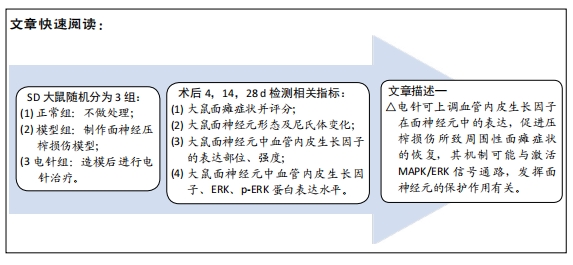
文题释义:
血管内皮生长因子:又称血管通透因子,是一种高度特异性的促血管内皮细胞生长因子,具有促进血管通透性增加、细胞外基质变性、血管内皮细胞迁移、增殖和血管形成等作用,在缺血性中枢病变以及周围神经损伤修复过程中发挥着重要作用。
MAPK信号通路:丝裂原活化蛋白激酶是细胞内的一类丝氨酸/苏氨酸蛋白激酶,能被多种外环境所激活,通过三级酶促级联反应进行信号转导,参与细胞增殖、分化、转化及凋亡等细胞生物学反应。
背景:电针可促进面神经再生,但其机制不明。血管内皮生长因子是一类可促进血管再生、增加血管通透性的细胞因子。
目的:观察电针对SD大鼠面神经颊支压榨损伤所致周围性面瘫的治疗效果,探究血管内皮生长因子/MAPK/ERK信号通路在上述过程中的作用。
方法:56只SD大鼠随机分成正常组(8只)、模型组(24只)、电针组(24只)。模型组和电针组均制作右侧面神经颊支压榨损伤模型,电针组术后每日于右侧“颊车”“地仓”穴行电针治疗,术后4,14,28 d,记录各组大鼠面瘫症状并评分,观察面神经元的形态及尼氏体变化,血管内皮生长因子的表达部位、强度以及血管内皮生长因子、ERK、p-ERK蛋白在面神经元组织的表达水平。
结果与结论:①模型组面瘫症状改善不如电针组明显,行为学评分在各时间点均低于电针组;②电针组面神经元尼氏体的形态恢复较模型组早且完全;③在术后各时间点电针组血管内皮生长因子的表达均高于模型组及正常组,p-ERK蛋白的表达均高于模型组,自术后14 d开始高于正常组;④结果表明,电针可上调血管内皮生长因子在面神经元中的表达,促进压榨损伤所致的周围性面瘫的恢复,其机制可能与激活MAPK/ERK信号通路,发挥面神经元的保护作用有关。
https://orcid.org/0000-0002-9531-7400 (李雷激)
中国组织工程研究杂志出版内容重点:组织构建;骨细胞;软骨细胞;细胞培养;成纤维细胞;血管内皮细胞;骨质疏松;组织工程
中图分类号:
